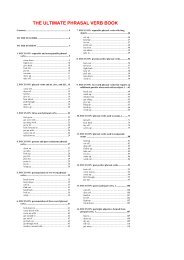Developing Speech and Language Skills - Noel's ESL eBook Library
Developing Speech and Language Skills - Noel's ESL eBook Library
Developing Speech and Language Skills - Noel's ESL eBook Library
Create successful ePaper yourself
Turn your PDF publications into a flip-book with our unique Google optimized e-Paper software.
Phoneme FactoryThe palate is very important for making speech sounds. We have already noticed thatthe tongue touches the roof of the mouth at different points for different consonants.Concentrate on the points at which the tongue touches the palate this time as you say‘t’, ‘s’, ‘r’, ‘n’, then ‘y’, then ‘k’, ‘g’, ‘ng’. You will notice that the points of contact arefurther back on the palate for each of the three sound types.The palate is in two parts. The hard palate is made of bone, <strong>and</strong> doesn’t move. The softpalate is made of muscle <strong>and</strong> moves during speech.Feel the palate with your tongue or finger. Right behind the top front teeth is a ridgeknown as the alveolar ridge.Many speech sounds are made through the tongue tip making contact with this ridge.By feeling with a finger or looking in a mirror you can notice the change from thehard to soft palate towards the back of the mouth. You can see the soft palate move ifyou look in the mirror <strong>and</strong> say ‘ah’. The soft palate closes the nasal cavity off fromthe mouth. This is necessary for eating <strong>and</strong> drinking <strong>and</strong> for speech. The sounds ‘m’,‘n’, <strong>and</strong> ‘ng’ however, require air to pass through the nose, so the soft palate is notraised when these sounds are spoken. Close your mouth <strong>and</strong> say ‘mmm’. You canhear the vibration in the nasal cavity <strong>and</strong> feel the air passing out of the nose.It is important to remember that many children with speech impairments do not haveanything wrong with the vocal tract. They need to learn the organisation of sounds inthe language, not to learn how to physically produce sounds.The organisation of speech sounds to create a phonological systemThe phonology of a language is the system of sounds in the language, <strong>and</strong> how thesounds combine.Each language varies in the number <strong>and</strong> types of sounds it contains, <strong>and</strong> in the waythey are combined. Japanese, for example, has no ‘r’ sound, <strong>and</strong> French <strong>and</strong> Germanhave no ‘th’ sound, so some French <strong>and</strong> German speakers of English pronounce thebeginning of words like ‘think’, <strong>and</strong> ‘this’ with an ‘s’ or ‘z’ sound. Likewise, Englishspeakers have trouble producing some of the unfamiliar sounds of Japanese <strong>and</strong>German.24











